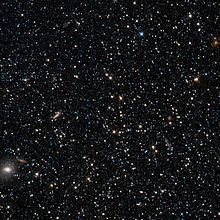- Dwarf galaxy
-
A dwarf galaxy is a small galaxy composed of up to several billion stars, a small number compared to our own Milky Way's 200-400 billion stars. The Large Magellanic Cloud, containing over 30 billion stars, is sometimes classified as a dwarf galaxy while others consider it a full-fledged galaxy orbiting the Milky Way galaxy.
Contents
Formation of dwarf galaxies
Current theory states that most galaxies, including dwarf galaxies, form in association with dark matter or out of gas containing metals. However, NASA's Galaxy Evolution Explorer space probe identified new dwarf galaxies forming out of gases lacking metals. These galaxies were located in the Leo Ring, a cloud of hydrogen and helium around two massive galaxies in the constellation Leo.[1]
Local dwarfs
 Phoenix dwarf galaxy is a dwarf irregular galaxy, features younger stars in its inner regions and older ones at its outskirts[2].
Phoenix dwarf galaxy is a dwarf irregular galaxy, features younger stars in its inner regions and older ones at its outskirts[2].
There are many dwarf galaxies in the Local Group: these small galaxies frequently orbit around larger galaxies, such as the Milky Way, the Andromeda Galaxy and the Triangulum Galaxy. A 2007 paper[3] has suggested that many dwarf galaxies were created by tidal forces during the early evolution of the Milky Way and Andromeda. Tidal dwarf galaxies are produced when galaxies collide and their gravitational masses interact. Streams of galactic material are pulled out away from the parent galaxies and the halos of dark matter that surround them.[4]
The Milky Way has 14 known dwarf galaxies orbiting it, and recent observations[5] have also led astronomers to believe the largest globular cluster in the Milky Way, Omega Centauri, is in fact the core of a dwarf galaxy with a black hole in its center, which was at some time absorbed by the Milky Way.
Dwarf galaxies
Dwarf galaxies come in many different morphologies:
- Elliptical galaxy: dwarf elliptical galaxy (dE) and its subtype dwarf spheroidal galaxy (dSph)
- Irregular galaxy: dwarf irregular galaxy (dI)
- Spiral galaxy: dwarf spiral galaxy
Hobbit galaxies
The recently coined term, hobbit galaxy has been used to describe galaxies smaller and dimmer than dwarf galaxies.[6][7]
Ultra Compact Dwarfs
Ultra Compact Dwarf galaxies (UCD) are a recently discovered class of very compact galaxies with very high stellar population counts. They are thought to be on the order of 200 light years across, with a hundred million stars.[8] It is theorized that these are the cores of nucleated dwarf elliptical galaxies, that have been stripped of gas and outlying stars by tidal interactions, travelling through the hearts of rich clusters.[9] UCDs have been found in the Virgo Cluster, Fornax Cluster, Abell 1689, Coma Cluster, amongst other clusters.[10]
Partial list of dwarf galaxies
- Aquarius Dwarf
- Canis Major Dwarf Galaxy
- Henize 2-10
- I Zwicky 18
- Irregular Galaxy IC 10
- Large Magellanic Cloud
- NGC 1569
- NGC 1705
- Pegasus Dwarf Irregular Galaxy
- Phoenix Dwarf
- Sagittarius Dwarf Elliptical Galaxy
- Sagittarius Dwarf Irregular Galaxy
- Sculptor Dwarf Galaxy
- Sculptor Dwarf Irregular Galaxy
- Sextans A
- Sextans Dwarf
- Small Magellanic Cloud
- Tucana Dwarf
- Ursa Minor Dwarf
- Willman 1
- Carina Dwarf
- Draco Dwarf
- Fornax Dwarf
- Leo II (dwarf galaxy)
See also
References
- ^ UPI, "New Recipe For Dwarf Galaxies: Start With Leftover Gas", Science Daily, 19 Feb 2009 [1]
- ^ "Hubble Sizes up a Dwarf Galaxy". Picture of the Week. ESA/Hubble. http://spacetelescope.org/images/potw1143a/. Retrieved 25 October 2011.
- ^ Metz, M.; Kroupa (2007). "Dwarf-spheroidal satellites: are they of tidal origin?". Monthly Notices of the Royal Astronomical Society 376: 387–392. arXiv:astro-ph/0701289. Bibcode 2007MNRAS.376..387M. doi:10.1111/j.1365-2966.2007.11438.x.
- ^ New Recipe for Dwarf Galaxies: Start with Leftover Gas Newswise, Retrieved on February 20, 2009.
- ^ Noyola, E. and Gebhardt, K. and Bergmann, M. (apr 2008). "Gemini and Hubble Space Telescope Evidence for an Intermediate-Mass Black Hole in ω Centauri". The Astrophysical Journal 676 (2): 1008–1015. arXiv:0801.2782. Bibcode 2008ApJ...676.1008N. doi:10.1086/529002.
- ^ SPACE.com - New 'Hobbit' Galaxies Discovered Around Milky Way
- ^ http://sciencenow.sciencemag.org/cgi/content/full/2007/109/1
- ^ Anglo-Australian Observatory Astronomers discover dozens of mini-galaxies 0100 AEST Friday 2 April 2004
- ^ Stelios Kazantzidis; Ben Moore; Lucio Mayer (2003). "Galaxies and Overmerging: What Does it Take to Destroy a Satellite Galaxy?". arXiv:astro-ph/0307362 [astro-ph].
- ^ Mieske; Infante; Benitez; Coe; Blakeslee; Zekser; Ford; Broadhurst et al. (2004). "Ultra Compact Dwarf galaxies in Abell 1689: a photometric study with the ACS". The Astronomical Journal 128 (4): 1529–1540. arXiv:astro-ph/0406613. Bibcode 2004AJ....128.1529M. doi:10.1086/423701.
External links
- Milky Way Satellite Galaxies
- SPACE.com article on "hobbit galaxies"
- Science article on "hobbit galaxies"
Galaxy Morphology - Elliptical galaxy
- Lenticular galaxy
- (unbarred
- barred)
- Spiral galaxy
- ([barred
- intermediate
- unbarred]
- [grand design
- flocculent
- Magellanic spiral])
- Irregular galaxy
- Dwarf galaxy
- Dwarf elliptical
- Dwarf spheroidal
- Dwarf spiral)
- Giant galaxy
- (Giant elliptical
- D-galaxy
- cD-galaxy)
Structure Active nuclei Energetic galaxies - Starburst galaxy
- (Wolf–Rayet
- BCD
- pea)
- LIRG
- (ULIRG
- HLIRG)
- LAE
Interaction Lists See also - Dark galaxy
- Intergalactic dust
- Intergalactic travel
- Intergalactic stars
 Book:Galaxies
Book:Galaxies Category:Galaxies
Category:Galaxies Portal:Astronomy
Portal:Astronomy
Categories:- Dwarf galaxies
- Galaxy morphological types
Wikimedia Foundation. 2010.

